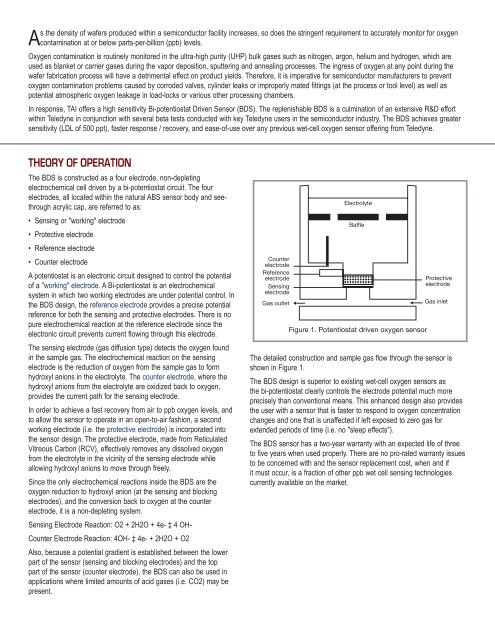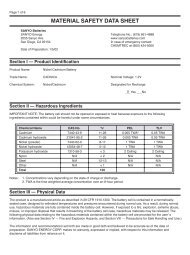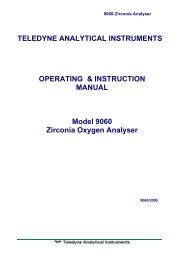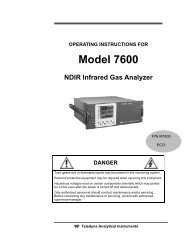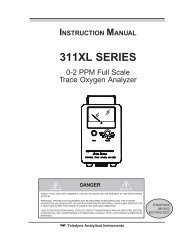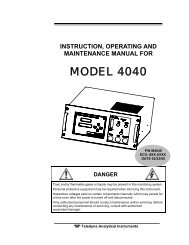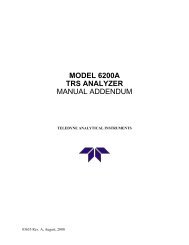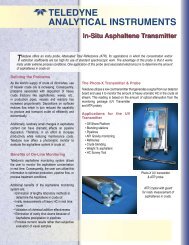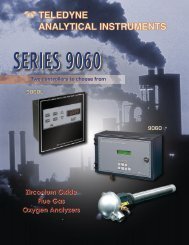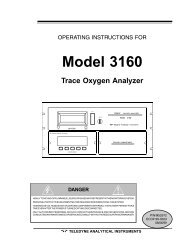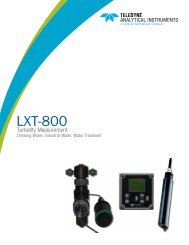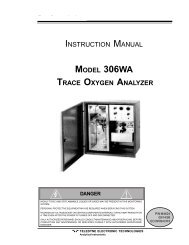Download the brochure - Teledyne Analytical Instruments
Download the brochure - Teledyne Analytical Instruments
Download the brochure - Teledyne Analytical Instruments
You also want an ePaper? Increase the reach of your titles
YUMPU automatically turns print PDFs into web optimized ePapers that Google loves.
As <strong>the</strong> density of wafers produced within a semiconductor facility increases, so does <strong>the</strong> stringent requirement to accurately monitor for oxygen<br />
contamination at or below parts-per-billion (ppb) levels.<br />
Oxygen contamination is routinely monitored in <strong>the</strong> ultra-high purity (UHP) bulk gases such as nitrogen, argon, helium and hydrogen, which are<br />
used as blanket or carrier gases during <strong>the</strong> vapor deposition, sputtering and annealing processes. The ingress of oxygen at any point during <strong>the</strong><br />
wafer fabrication process will have a detrimental effect on product yields. Therefore, it is imperative for semiconductor manufacturers to prevent<br />
oxygen contamination problems caused by corroded valves, cylinder leaks or improperly mated fittings (at <strong>the</strong> process or tool level) as well as<br />
potential atmospheric oxygen leakage in load-locks or various o<strong>the</strong>r processing chambers.<br />
In response, TAI offers a high sensitivity Bi-potentiostat Driven Sensor (BDS). The replenishable BDS is a culmination of an extensive R&D effort<br />
within <strong>Teledyne</strong> in conjunction with several beta tests conducted with key <strong>Teledyne</strong> users in <strong>the</strong> semiconductor industry. The BDS achieves greater<br />
sensitivity (LDL of 500 ppt), faster response / recovery, and ease-of-use over any previous wet-cell oxygen sensor offering from <strong>Teledyne</strong>.<br />
THEORY OF OPERATION<br />
The BDS is constructed as a four electrode, non-depleting<br />
electrochemical cell driven by a bi-potentiostat circuit. The four<br />
electrodes, all located within <strong>the</strong> natural ABS sensor body and seethrough<br />
acrylic cap, are referred to as:<br />
• Sensing or "working" electrode<br />
• Protective electrode<br />
• Reference electrode<br />
• Counter electrode<br />
A potentiostat is an electronic circuit designed to control <strong>the</strong> potential<br />
of a "working" electrode. A Bi-potentiostat is an electrochemical<br />
system in which two working electrodes are under potential control. In<br />
<strong>the</strong> BDS design, <strong>the</strong> reference electrode provides a precise potential<br />
reference for both <strong>the</strong> sensing and protective electrodes. There is no<br />
pure electrochemical reaction at <strong>the</strong> reference electrode since <strong>the</strong><br />
electronic circuit prevents current flowing through this electrode.<br />
The sensing electrode (gas diffusion type) detects <strong>the</strong> oxygen found<br />
in <strong>the</strong> sample gas. The electrochemical reaction on <strong>the</strong> sensing<br />
electrode is <strong>the</strong> reduction of oxygen from <strong>the</strong> sample gas to form<br />
hydroxyl anions in <strong>the</strong> electrolyte. The counter electrode, where <strong>the</strong><br />
hydroxyl anions from <strong>the</strong> electrolyte are oxidized back to oxygen,<br />
provides <strong>the</strong> current path for <strong>the</strong> sensing electrode.<br />
In order to achieve a fast recovery from air to ppb oxygen levels, and<br />
to allow <strong>the</strong> sensor to operate in an open-to-air fashion, a second<br />
working electrode (i.e. <strong>the</strong> protective electrode) is incorporated into<br />
<strong>the</strong> sensor design. The protective electrode, made from Reticulated<br />
Vitreous Carbon (RCV), effectively removes any dissolved oxygen<br />
from <strong>the</strong> electrolyte in <strong>the</strong> vicinity of <strong>the</strong> sensing electrode while<br />
allowing hydroxyl anions to move through freely.<br />
Since <strong>the</strong> only electrochemical reactions inside <strong>the</strong> BDS are <strong>the</strong><br />
oxygen reduction to hydroxyl anion (at <strong>the</strong> sensing and blocking<br />
electrodes), and <strong>the</strong> conversion back to oxygen at <strong>the</strong> counter<br />
electrode, it is a non-depleting system.<br />
Sensing Electrode Reaction: O2 + 2H2O + 4e- ‡ 4 OH-<br />
Counter Electrode Reaction: 4OH- ‡ 4e- + 2H2O + O2<br />
Also, because a potential gradient is established between <strong>the</strong> lower<br />
part of <strong>the</strong> sensor (sensing and blocking electrodes) and <strong>the</strong> top<br />
part of <strong>the</strong> sensor (counter electrode), <strong>the</strong> BDS can also be used in<br />
applications where limited amounts of acid gases (i.e. CO2) may be<br />
present.<br />
Counter<br />
electrode<br />
Reference<br />
electrode<br />
Sensing<br />
electrode<br />
Gas outlet<br />
Electrolyte<br />
Baffle<br />
Figure 1. Potentiostat driven oxygen sensor<br />
Protective<br />
electrode<br />
Gas inlet<br />
The detailed construction and sample gas flow through <strong>the</strong> sensor is<br />
shown in Figure 1.<br />
The BDS design is superior to existing wet-cell oxygen sensors as<br />
<strong>the</strong> bi-potentiostat clearly controls <strong>the</strong> electrode potential much more<br />
precisely than conventional means. This enhanced design also provides<br />
<strong>the</strong> user with a sensor that is faster to respond to oxygen concentration<br />
changes and one that is unaffected if left exposed to zero gas for<br />
extended periods of time (i.e. no "sleep effects").<br />
The BDS sensor has a two-year warranty with an expected life of three<br />
to five years when used properly. There are no pro-rated warranty issues<br />
to be concerned with and <strong>the</strong> sensor replacement cost, when and if<br />
it must occur, is a fraction of o<strong>the</strong>r ppb wet cell sensing technologies<br />
currently available on <strong>the</strong> market.


